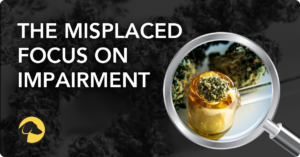
Part Two: 2023 Drug Testing Industry Trends
In Part Two of our blog series on trends for 2023, the expert team at Hounds Labs continues to build on our theme, ‘The Year of the Policy.’ Nina M. French, President of Employer + Law Enforcement Solutions, discusses continuous monitoring and the rationale behind creating policies that more frequently test a wider range of employees. Aaron Atkinson, Senior Vice President of Marketing, reflects on the history of zero-tolerance drug testing programs and the new approach that better reflects the realities of cannabis legalization. Finally, Don Boian, Chief Information Security Officer, highlights why workplace drug testing policies need to expand the concept of safety-sensitive to encompass security, Information Technology, and support personnel.
NINA M. FRENCH – PRESIDENT OF EMPLOYER + LAW ENFORCEMENT SOLUTIONS
Workplace drug testing, at its core, is a risk mitigation tool that depends on testing to deter drug use at work. As simple as that seems, many employers use drug testing for hiring purposes only, relying on the drug test as part of the candidate selection process. Although pre-employment testing can effectively screen candidates who are using drugs during the hiring cycle, pre-employment testing is far less effective when used as a standalone reason for testing. Drug testing is most effective when implemented as part of a comprehensive testing program with continuous monitoring to help navigate evolving cannabis laws and lower exposure to risk.
A comprehensive testing program can be customized to meet the requirements of each employer, but any robust testing program should include one core element: objectivity. Objectivity in drug testing ensures that all types of employees, safety-sensitive and beyond, are periodically tested throughout the employment continuum to reinforce compliance with the company’s drug testing policies. Considering that the National Safety Council reports the average cost of a single workers’ compensation claim in 2019 and 2020 exceeded $41,000 per incident, implementing a continuous monitoring program can yield a substantial return on investment for all categories of employers.1
AARON ATKINSON – SENIOR VICE PRESIDENT OF MARKETING
Over the past decade, and certainly, since Covid, employers have faced increasing challenges related to their workplace drug testing programs. Cannabis legalization, in part, initiated a shift away from traditional zero-tolerance testing programs. In 2023, I expect multiple factors to compound a trend many employers are already experiencing: feeling caught between a rock and a hard place.
Workplace drug testing initially focused on zero-tolerance. Employers who chose to test typically used oral fluid, urine, or hair samples to screen for various drugs, including amphetamines, cocaine, opiates, phencyclidine2, and cannabis. In these testing programs, the adverse action for a positive test result was explicit: an applicant would not be hired, or an existing employee would be terminated.
Now, more and more employers are adapting their legacy testing programs in response to current macroeconomic factors. First, cannabis legalization is increasing access, use, and drug test positivity, making it harder for employers to find applicants and employees who can yield negative drug test results.3 Second, Covid has made it increasingly complex for some employers to attract and retain staff. Third, a swell of advocacy movements against THC metabolite testing is confusing employers. Finally, laws are changing, and employees are increasingly filing wrongful termination lawsuits against employers.
So, the rock combines legislative and social trends complicating employer decisions about how, and if, to test for cannabis. And the hard place involves policy changes needed to keep the workplace safe, fully staffed, and fair for all parties involved. Employers will likely continue to feel stuck in this tight spot in 2023, but I’m confident recent use breath testing will start to play an important role in helping employers successfully navigate these challenges and avoid the pinch that exists between the rock and the hard place.
DON BOIAN – CHIEF INFORMATION SECURITY OFFICER
In cybersecurity, 2022 held many accomplishments worthy of celebration: shared awareness of threats and protective actions, increased workforce diversity, takedowns of major threat actors,4 government sharing of vulnerabilities, and many more. Looking forward to 2023, we will continue to see heightened risks such as ransomware and the occurrence of destructive malware. Safety awareness in physical and virtual spaces will remain an important business objective. Organizations must meet these challenges by focusing on the critical information driving their businesses and establishing comprehensive information security plans and programs to protect it.
In addition to security plans, forward-thinking businesses are also creating policies to protect employees in safety-sensitive positions. The year ahead will see many companies adapting to changing state and local laws allowing cannabis for either recreational or medicinal use. In light of these changes, policies may include added measures to prevent hazardous situations created by employee substance abuse during the workday.
An employee working under the influence of cannabis has long been considered a physical risk for safety-sensitive positions. A growing consideration is how an employee who uses cannabis during the workday might impact a company’s information or automation environment. A breach, sensitive information leak, or even an outage can cripple a business and severely impact revenue. However, the future is bright in 2023 for companies with solid risk management frameworks that consider risks beyond traditional safety-sensitive positions.
SAFE + FAIR IN 2023
Testing breath for cannabis will enable employers to make policy changes focused on detecting and deterring cannabis use during the workday. The narrow detection window for cannabis breath testing will allow employers to maintain safety while treating employees fairly. Updating policies and implementing a recent use test designed for the era of cannabis legalization is a better way to address the needs of employers and employees in 2023 and beyond.
To read more trends from other Hound Labs experts, head to Part One of this series.
Footnotes
1 National Safety Council
2 Drug Enforcement Administration
3 Quest Blog
4 Proofpoint

January 26, 2023
By JENNY LYNN
Co-Founder
Share












